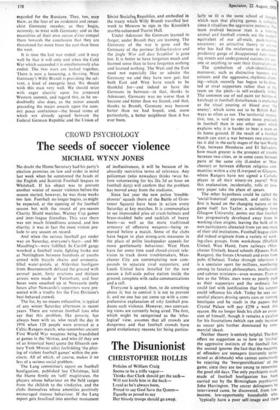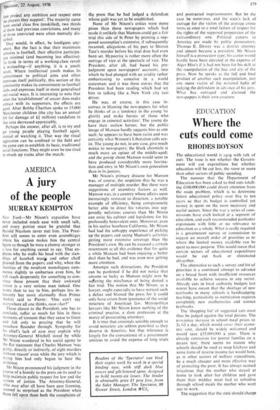CROWD PSYCHOLOGY
The seeds of soccer violence
MICHAEL WYNN JONES
No doubt the Home Secretary had his party's election promises on law and order in mind last week when he summoned the heads of the English and Scottish Football leagues to Whitehall. If his object was to prevent another winter of soccer violence before the season started, however, he was three weeks too late. Football no longer begins, as might be expected, at the opening of the football season but with the round of pre-season Charity Shield matches, Watney Cup games and inter-league friendlies. This year there was not much friendliness around, and less charity; it was in fact the most violent pre- lude to any season on record.
And when the serious football got under way on Saturday, everyone's fears—and Mr Maudling's—were fulfilled. In Cardiff gangs wrecked a football train, fighting broke out at Nottingham between hundreds of youths armed with bicycle chains and ammonia- filled water-pistols, at Aldershot hooligans from Bournemouth defaced the ground with aerosol paint, forty evictions and thirteen arrests were made at Tottenham, and four buses were smashed up at Newcastle (only hours after Newcastle's supporters were pre- sented with a trophy for the First Division's best-behaved crowd).
The list, by no means exhaustive, is typical of any winter Saturday afternoon in recent years. There are veteran football fans who say that this problem, like poverty, has always been with us, who recall the day in 1936 when 120 people were arrested at a Celtic-Rangers match, who remember ancient First World War weapons being. brandished at games in the 'thirties, and who (if they are of an historical bent) quote the fifteenth cen- tury York Minster edict forbidding 'the play- ing of violent football games' within the pre- cincts. All of which, of course, makes it no less of a serious social problem.
The Lang committee's report on football hooliganism, published last Christmas, laid the blame firmly on 'soft' magistrates, the players whose behaviour on the field ranges from the childish to the vindictive, and the clubs themselves whose amenities positively encouraged riotous behaviour. If the Lang report gets fossilised into another monument
of ineffectiveness, it will be because of its absurdly restrictive terms of reference. Any policeman (who nowadays thinks twice be- fore volunteering for his 26s 3d an hour on football duty) will confirm that the problem has moved away from the stadiums.
Since last year the new police 'trouble- shooter' squads (born of the Battle of Gros- venor Square) have been in action every Saturday at key matches. It is commonplace to see impounded piles of crash-helmets and brass-studded belts and rackfuls of heavy boots—as well as the more traditional armoury of offensive weapons—being re- moved before a match. Some of the clubs have begun to plan strong-arm measures in the place of polite loudspeaker appeals for more gentlemanly behaviour. West Ham have for some time used closed-circuit tele- vision to track down troublemakers, Man- chester City are contemplating new com- pounds to separate rival supporters, and Leeds United have installed for the new season a full-scale police station inside the ground, complete with radio communications and a cell.
Everyone is agreed, then, to do something about it; but to control it is not to prevent it, and no one has yet come up with a com- prehensive explanation of why football pro- duces such violence. However, two contrast- ing views are currently being aired. The first, which might be categorised as the 'etho- logical' view, assumes that all crowds are dangerous and that football crowds have good evolutionary reasons for being particu-
larly so (it is the same school of thought which says that playing games is cathartic since it ritualises the aggressive instincts). The team evolved because man is a hunting animal and football crowds are the modern equivalent of our all-male, pack-hunting ancestors: an attractive theory to anyone who has had the misfortune to encounter predatory gangs of disappointed fans roam. ing streets and underground stations for any- one or anything to vent their frustrations on. The symbolism of club-identification. moreover, such as distinctive banners and colours and the aggressive, rhythmic chant- ing—which recently has begun to be direc- ted at rival supporters rather than at the team on the pitch—is self-evidently tribal. The common use of red paint (or bottles of ketchup) in football disturbances is explained as the ritual pouring of blood over 'the enemy', which turns out to be British Rail- ways as often as not. The territorial impera- tive, too, is said to operate more precisely in football than in any other sport which explains why it is harder to beat a team on its home ground. If the result of a football match can start a war between two countries (as it did in the early stages of the last World Cup, between Honduras and El Salvador), how much greater is the prospect of trouble between two cities, or in some cases between parts of the same city (London or Man- chester) or between different religious com- munities within a city (Liverpool or Glasgow, where Rangers have not signed a Catholic player in all their ninety-six years)? With this explanation, incidentally, rolls of lava- tory paper take the place of spears.
The other hypothesis could be called the `social-historical' approach, and unlike the first is based on the changing nature of the game itself. Ian Taylor, a sociologist from Glasgow University, points out that football has progressively developed away from its working-class origins, leaving the bulk of its non-participants alienated from yet one more of their old institutions. Football league clubs did indeed originate from a variety of work- ing-class groups, from workshops (Sheffield United, West Ham), from railways (Man- chester United), board schools (Queens Park Rangers), the forces (Arsenal) and even from pubs (Chelsea). Today through television it is a spectator sport for millions, numbering among its fanatics philosophers, intellectuals and cabinet ministers—even women. Even as late as the 'fifties, stars were as poorly paid as their supporters and the ordinary fan could feel with justification that his support could influence his club. Today he sees suc- cessful players driving sports cars or running boutiques and he reads in the papers that Crystal Palace will pay £250 a week this season. He no longer finds his club an exten- sion of himself, though it remains a catalyst for his frustrations (which can only increase as soccer gets 'further dominated by com- mercial ideas).
Neither theory is entirely helpful. The first offers no suggestion as to how to 'civilise' the aggressive instincts of the football fan; the second ignores the fact that the majority of offenders are teenagers (currently epito- mised as skinheads) who cannot consciously be rejecting the 'bourgeoisification' of the game, since they are too young to remember the good old days. The only psychiatric study made of football hooliganism has been carried out by the Birmingham psychiatrist John Harrington. The soccer delinquents he interviewed came, he discovered, from low- income, low-opportunity households who 'typically have a poor self-image and there' fore project any ambition and respect onto the players they support'. The majority came from social class five (unskilled), two thirds of them had previous convictions, and many of those convicted were often mentally dis- turbed. They would, in effect, be hooligans any- where. But the fact is that their maximum stimulus is football, their effective participa- tion minimal (and becoming less effective). To think in terms of a working-class revolt is misleading—if anything, it is a youth revolt. Where intellectual youth makes its commitment to political aims and often expresses itself politically, this section of the community makes its commitment to football clubs and expresses itself in more generalised anti-social ways. It is interesting to note that when the 'establishment' of soccer does make contact with its supporters, the effects are good. After Bobby Charlton spoke to 15,000 Manchester children (the city has an annual
bill for damage of million) vandalism in that area decreased appreciably.
Perhaps the answer, after all, is to try and get young people playing football again, instead of watching it. That way the ritual aggression can be confined to the field and the game can re-establish its basic, traditional social functions. They might even be too tired to smash up trains after the match.































 Previous page
Previous page